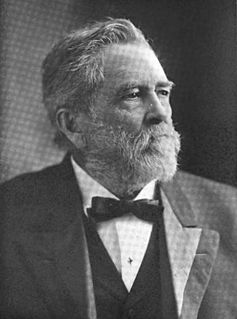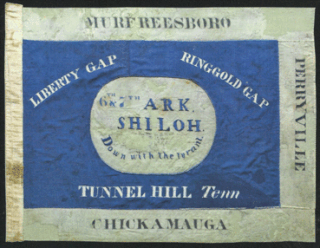Related Research Articles

George Hillyer was an American politician, serving as the 29th Mayor of Atlanta, Georgia, as well as a state representative and senator. He was also an officer in the Confederate States Army during the American Civil War.
The 76th Ohio Infantry Regiment, sometimes 76th Regiment, Ohio Volunteer Infantry was an infantry regiment of the Union Army during the American Civil War. The regiment served in the Western Theater, primarily as part of the XV Corps in the Army of the Tennessee.

The 22nd Alabama Infantry Regiment was an infantry regiment that served in the Confederate Army during the American Civil War.

The 1st Arkansas Infantry (1861–1865) was a Confederate Army infantry regiment during the American Civil War. The regiment was raised in April 1861 by Colonel Thompson B. Flournoy. It moved first to Virginia, but transferred back to Tennessee and served the rest of the war in the western theater, seeing action in the Kentucky, Tennessee and Georgia campaigns. Following its depletion in numbers, the regiment was consolidated several times with other Arkansas regiments, finally merging in 1865 into the 1st Arkansas Consolidated Infantry Regiment. There were three regiments known as "1st Arkansas" during the war. The second unit with the designation of "1st Arkansas" was the 1st Infantry, Arkansas State Troops, which was mustered into Confederate service at Pitman's Ferry, Arkansas, on 23 July 1861, under the command of Colonel Patrick Cleburne; this unit was eventually redesignated as the 15th Arkansas Volunteer Infantry. The third unit bearing the title "1st Arkansas" was the 1st Arkansas Volunteer Infantry, which served with the Union Army.

The 6th Arkansas Infantry Regiment was a regiment of the Confederate States Army during the American Civil War. Organized mainly from volunteer companies, including several prewar volunteer militia units, raised in the southern half of Arkansas, the regiment was among the first transferred to Confederate Service. It served virtually the entire war in Confederate forces east of the Mississippi River. After the unit sustained heavy casualties during the Battle of Shiloh and Bragg's Kentucky Campaign, the unit spent most of the rest of the war field consolidated with the 7th Arkansas Infantry Regiment, to form the 6th/7th Arkansas Infantry Regiment.

The 5th Arkansas Infantry, also called the Fighting Fifth (1861–1865) was a Confederate Army infantry regiment organized in Arkansas to serve for the Confederate States of America during the American Civil War. It served throughout the war in the western theater, seeing action in the Kentucky, Tennessee and Georgia campaigns. Following its depletion in numbers the regiment was consolidated several times with other Arkansas regiments, finally merging in 1865 into the 1st Arkansas Consolidated Infantry Regiment. Another Arkansas unit also had the designation 5th Arkansas, the 5th Regiment, Arkansas State Troops which participated in the Battle of Wilson's Creek, but was never transferred to Confederate Service. There is no connection between the two units.
The 54th Indiana Infantry, an American Civil War regiment, was organized at Indianapolis, Indiana, on October 28, 1862, with Fielding Mansfield as colonel, and it was made up mostly of volunteers from all over the state. In December, the regiment left for Memphis, Tennessee.

The Choctaw in the American Civil War participated in two major arenas— the Trans-Mississippi and Western Theaters. The Trans-Mississippi had the Choctaw Nation. The Western had the Mississippi Choctaw. The Choctaw Nation had been mostly removed west prior to the War, but the Mississippi Choctaw had remained in the east. Both the Choctaw Nation and the Mississippi Choctaw would ultimately side with the Confederate States of America.

The 84th Regiment Indiana Infantry was an infantry regiment that served in the Union Army during the American Civil War.

The history of the Arkansas State Guard and the Spanish–American War begins with the reorganization of the state militia following the end of Reconstruction. In 1879 the Arkansas Legislature had abolished the office of Adjutant General in retaliation for the use of the state militia to interfere in local political matters during reconstruction. During this period the Governor's Private Secretary performed the duties of the Adjutant General as an additional duty, and the legislature provided no appropriated funds for the state guard. Several companies existed during this period, including the Quapaw Guards and the McCarthy Guard in Little Rock. In 1897 the Arkansas State Guard was reorganized to consist of four infantry regiments, two artillery batteries and a cavalry squadron. In 1897, the state provided two volunteer infantry regiments for the Spanish–American War and although these two Arkansas Volunteer Infantry Regiments were not deployed overseas and did not see actual combat, they did suffer a number of casualties from disease.
The 13th Arkansas Infantry (1861–1865) was a Confederate Army infantry regiment during the American Civil War. Organized mainly from companies, including several prewar volunteer militia companies, raised in northeastern Arkansas, the regiment was among the first transferred to Confederate Service, and spent virtually the entire war serving in Confederate forces east of the Mississippi River. After the unit sustained heavy casualties during the Battle of Murfreesboro, the unit spent most of the rest of the war field consolidated with the 13th Arkansas Infantry Regiment, to form the 5th/13th Arkansas Infantry Regiment.

The 7th Arkansas Volunteer Infantry (1861−1865) was a Confederate Army infantry regiment during the American Civil War. Organized mainly from companies, including several prewar volunteer militia companies, raised in northeastern Arkansas, the regiment was among the first transferred to Confederate service, and spent virtually the entire war serving east of the Mississippi River. After the unit sustained heavy casualties in the Battle of Shiloh and the Kentucky Campaign, the unit spent most of the rest of the war field consolidated with the 6th Arkansas Infantry Regiment to form the 6th/7th Arkansas Infantry Regiment.
The 15th Arkansas Infantry Regiment or Josey's Arkansas Infantry Regiment was an infantry formation in the Confederate States Army during the American Civil War. The regiment was organized in May 1861 under the command of Colonel Patrick Cleburne. It served throughout the war in the western theater, seeing action in the Kentucky, Tennessee, and Georgia campaigns. Following its depletion in numbers the regiment was consolidated several times with other Arkansas regiments, finally merging in 1865 into the 1st Arkansas Consolidated Infantry Regiment. There were two other regiments which also received the designation of "15th Arkansas". The 21st (McRae's) Arkansas Infantry was redesignated 15th Arkansas in February 1863, but to avoid confusion, was normally referred to as the 15th (Northwest) Arkansas Infantry Regiment. This second "15th Arkansas" was surrendered at Vicksburg in July 1863. A third regiment, under command of Colonels Gee and later Johnson, also received the designation 15th Arkansas Infantry. This last regiment surrendered at Port Hudson, Louisiana, in July 1863.

The 18th Arkansas Infantry (Marmaduke's) (1861–1865) was a Confederate Army infantry regiment during the American Civil War. The unit was also briefly identified as the 1st Arkansas Infantry Battalion. The unit was most often referred to as the 3rd Confederate Infantry Regiment. The designation "Confederate Infantry Regiment" was intended to convey the difference between Provisional Confederate Army units and Regular Confederate Army Units, with Provisional units being those regiments who received a state designation such as "XX Arkansas Infantry Regiment". In practice, the designation was most often utilized when Regiments were assembled utilizing companies from more than one Confederate state. The "3rd Confederate Infantry Regiment" is occasionally misidentified as the 3rd Arkansas Infantry Regiment commanded by Colonel Van H. Manning.

The 9th Arkansas Infantry Regiment was a regiment of the Confederate States Army during the American Civil War. It served in the Western Theater, seeing action in the Vicksburg, Tennessee and Georgia campaigns. Due to attrition; the 9th Arkansas was consolidated several times with other Arkansas regiments, finally merging in 1865 into the 1st Arkansas Consolidated Mounted Rifles.
The 24th Arkansas Infantry (1861–1865) was a Confederate Army infantry regiment during the American Civil War. The unit began its service in the Department of the Trans-Mississippi, but the bulk of the unit was captured at the Battle of Arkansas Post and shipped to Northern prison camps. The unit was exchanged in Virginia and shipped to Tennessee and joined the Army of Tennessee in time for the Chattanooga Campaign and remained with the army through the Atlanta Campaign, the Franklin-Nashville Campaign and ended the war in North Carolina.

The 19th (Dawson's) Arkansas Infantry (1861–1865) was a Confederate Army infantry regiment during the American Civil War. The regiment was present for but not engaged during the Battle of Pea Ridge. At the Battle of Arkansas Post, the regiment became split, with part of the regiment surrendering with the garrison when the post capitulated. The captured portion of the regiment was eventually exchanged and released on the east side of the Mississippi and served the remainder of the war with the Confederate Army of Tennessee. The un-captured portion of the regiment was consolidated with the remnants of the 24th Arkansas and served the remainder of the war in the Department of the Trans-Mississippi.
The 1st Arkansas Light Artillery, originally known as the Fort Smith Artillery (1861), was an artillery battery of the Confederate States Army that served during the American Civil War. The unit was actually a pre-war volunteer militia company which was activated as part of the Arkansas State Troops and mustered out of state service following the Battle of Wilson's Creek. The unit immediately re-organized and re-enlisted for Confederate service. The unit spent the majority of the war in the western theater, fighting as part of the Confederate Army of Tennessee. The unit is also known as Reid's Battery, Provence's Battery, Humphreys' Battery and finally Rivers' Battery.
The 43rd Mississippi Infantry Regiment was a regiment of infantry in the Confederate States Army. It fought in many battles and campaigns of the American Civil War.

Henshaw's Battery Illinois Light Artillery was an artillery battery from Illinois that served in the Union Army during the American Civil War. The battery was mustered into service in December 1862 and assigned to guard duty in Kentucky. In July 1863, the battery helped capture John Hunt Morgan's raiders at Buffington Island and Salineville. Beginning in August 1863, the unit took part in Ambrose Burnside's campaign in east Tennessee and the Knoxville campaign. It spent the rest of the war on garrison in east Tennessee before being mustered out of service in July 1865.
References
- 1 2 Thomas H. Martin (1902). Atlanta and Its Builders: A Comprehensive History of the Gate City of the South. 1. Century Memorial Pub. Co. pp. 175–176.
- 1 2 Franklin M. Garrett (June 1969). Atlanta and Environs. p. 550. ISBN 9780820302638.